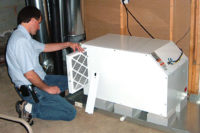Studies have shown in America around 47% of homes have shown signs of some form of mold. Research by mold remediation experts FDP Mold Remediation has discovered which states of the 48 contiguous states are most at risk from mold based on some key metrics that can be attributed to higher chances of mold growing in and outside of your home. These include average rainfall, average temperature, average humidity and the average age of homes in every state. These were each given a score out 10 to provide a total out of 40 on the ‘mold index’.
It's estimated that mold remediation will cost, on average, $2,347, so if you see signs of mold, it’s best to deal with the issue straight away or be left with a hefty bill.
The states with the highest risk of mold
State |
Mold Index |
Florida |
38.76 |
Mississippi |
38.66 |
Louisiana |
38.52 |
Alabama |
37.69 |
Tennessee |
36.51 |
Arkansas |
36.15 |
Georgia |
35.73 |
South Carolina |
35.50 |
North Carolina |
35.20 |
West Virginia |
35.16 |
Florida is ranked as the state which may struggle with mold the most. It is known for its sub-tropical climate with high temperatures averaging 73°F across the year. Florida also experiences a lot of rainfall with an average of 54.6 inches. These factors create a perfect environment for mold if not managed efficiently.
Mississippi is next in the ranking, mostly due to the climate; this state has a high average humidity (72.5%) and the most amount of rainfall of all the states, with 59.44 inches on average.
Louisiana is the third state most at risk from mold (38.52). The humidity in Louisiana averages around 74% which is actually higher than both Florida and Mississippi. However, the rankings for temperature and rainfall are slightly lower than these top runners.
The fourth moldiest state is Alabama, another state which has high average temperatures (65.4°F) coupled with high average rainfall (57.86 inches). This combination creates a breeding ground for mold as it thrives in moist and warm environments. The average year houses are built is around 1985, so this factor could also contribute to mold issues in homes.
Tennessee is the fifth most at-risk state from mold. 5.7% of homes in this state were built before 1939 so there are houses around 85 years old. The average house was built in 1985 as well so many structures may suffer from issues relating to mold. Especially as the humid subtropical climate means mold spores can thrive if not kept under control.
Northeastern United States at Moderate Mold Risk
Though not in the top 10 states with the highest mold index, it should be noted that the research reveals that the states in the Northeast all rank in the top 60% for mold risk. New Jersey is the highest, with a mold index of 34.58, followed in descending order by Rhode Island, Maine, Maryland, Delaware, New York, Massachusetts, Pennsylvania, Connecticut, Washington D.C., and Vermont, which rounds out the region with a mold index of 32.61.
The states with the lowest risk of mold
State |
Mold Index |
Nevada |
25.46 |
Wyoming |
25.50 |
Colorado |
25.57 |
Arizona |
25.70 |
New Mexico |
25.91 |
Utah |
26.17 |
Montana |
26.87 |
Idaho |
27.08 |
North Dakota |
27.68 |
South Dakota |
28.46 |
Nevada is America's least moldy state with a score of 25.46 on the index. Nevada is America's driest state, made up of deserts and semi-arid landscapes the climate prevents the moisture that mold usually thrives in. The state only gets an average rainfall of around 8 inches, and only 1% of houses were built before 1939, so it is likely buildings are newer and less likely to have issues.
The second state with the least issues with mold is Wyoming. The average rainfall in this state is only 14.74 inches, which is extremely low compared to most of America. Less moisture means there is a lower chance of mold, and thus the state has a low score of 25.50.
Colorado is the third state on this list. Colorado has a low average humidity of 47.5% as well as low average rainfall (16.49 inches). This means there is less chance of mold growing as the conditions aren’t optimal for growth.
Arizona has some of the highest average temperatures across America (62.9°F), which combined with low rainfall (12.09 inches) creates an environment that is hard for mold to grow. The houses in Arizona also have an average age of around 33 years so they are likely to have better structures and ventilation to prevent mold growth inside.
In fifth place you can find New Mexico. The climate in New Mexico is distinguished by low average rainfall (14.1 inches), a moderate average temperature of 56.2 along with low humidity at 44.5%.
Utah is the sixth least moldy state. Not only does Utah have a dry, semi-arid and desert climate, with low rainfall (11.4 inches) and low average humidity (55%). But the median house age is only around 34 years (median year built 1990).
A spokesperson from FDP Mold Remediation commented “In homes across America, a quiet problem lurks—mold. It sneaks in unnoticed, thriving in neglected corners and damp spaces. Mold isn't just a cosmetic issue; it poses a risk to both homes and health.
To tackle the mold problem, we need more than just surface cleaning. It's about recognizing the importance of ongoing care, moisture control, and good ventilation. Prevention is key; the battle against mold is won through daily practices that maintain a healthy living environment.”







